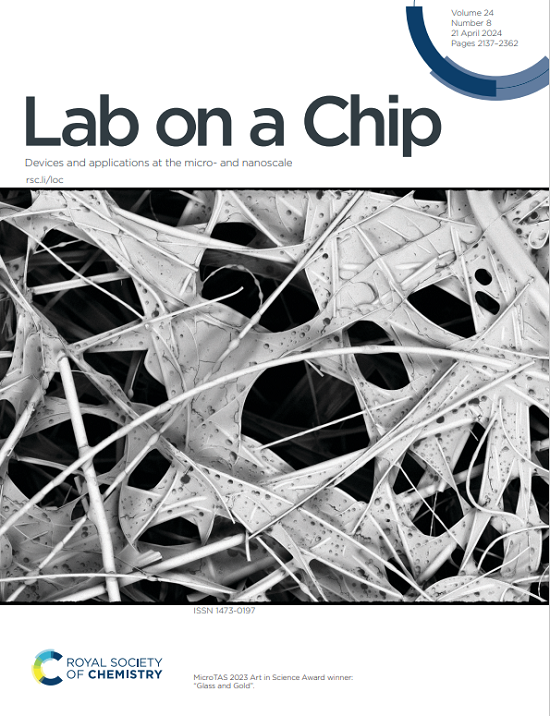Scalable and ultrafast CAR-T cell production using microfluidics.
IF 6.1
2区 工程技术
Q1 BIOCHEMICAL RESEARCH METHODS
引用次数: 0
Abstract
Chimeric antigen receptor T cell (CAR-T) therapy has recently gained recognition as a transformative treatment of cancer, particularly of hematological malignancies. However, CAR-T manufacturing remains a major bottleneck of this treatment modality; in standard cases, it takes up to two weeks, resulting in a phenotypic shift toward terminally differentiated T-cells and a significant depletion of T-cells with naive-like phenotype (Tnlp), crucial for sustained clinical efficacy. Leveraging the current progress in microfluidic technologies, we develop and optimize a microfluidic device (MFD) for CAR-T cell production via an ultrafast protocol that integrates T-cell activation and lentiviral transduction in a single step within 24 hours. The MFD geometry allowed reaching a transduction rate of 27% (for MOI 3) compared to 17% and 8% transduction (MOI 3) in 48- and 6-well plates, respectively, used as controls. Notably, in the ultrafast protocol in our MFD, the amount of CD3+ Tnlp is approximately six times higher than that remaining after the standard 9 day protocol (18.07 ± 6.03% vs. 3.97 ± 2.37%). A similar pattern is noted for CD4+ and CD8+ Tnlp, with percentages of 11.07 ± 6.08% vs. 3.56 ± 3.52% and 29.2 ± 7.11% vs. 4.18 ± 1.69%, respectively, in the final CAR-T product. Our results highlight MFDs as a scalable platform to streamline CAR-T manufacturing, with the potential to improve clinical accessibility and outcomes by reducing the production time while preserving essential T-cell phenotypes.使用微流体的可扩展和超快速CAR-T细胞生产。
嵌合抗原受体T细胞(CAR-T)疗法最近被认为是癌症,特别是血液系统恶性肿瘤的一种变革性治疗方法。然而,CAR-T制造仍然是这种治疗方式的主要瓶颈;在标准病例中,它需要长达两周的时间,导致表型向终末分化的t细胞转移,并且具有幼稚样表型(Tnlp)的t细胞显著耗竭,这对于持续的临床疗效至关重要。利用当前微流控技术的进展,我们开发并优化了一种用于CAR-T细胞生产的微流控装置(MFD),该装置通过超快协议在24小时内将t细胞激活和慢病毒转导集成在一个步骤中。MFD的几何形状可以达到27%的转导率(MOI 3),而作为对照的48孔板和6孔板分别为17%和8%的转导率(MOI 3)。值得注意的是,在我们的MFD超快方案中,CD3+ Tnlp的数量大约是标准9天方案后剩余量的6倍(18.07±6.03% vs. 3.97±2.37%)。CD4+和CD8+ Tnlp在最终CAR-T产品中的比例分别为11.07±6.08%对3.56±3.52%和29.2±7.11%对4.18±1.69%。我们的研究结果强调,mfd是一个可扩展的平台,可以简化CAR-T制造,通过减少生产时间,同时保留必要的t细胞表型,有可能改善临床可及性和结果。
本文章由计算机程序翻译,如有差异,请以英文原文为准。
求助全文
约1分钟内获得全文
求助全文
来源期刊

Lab on a Chip
工程技术-化学综合
CiteScore
11.10
自引率
8.20%
发文量
434
审稿时长
2.6 months
期刊介绍:
Lab on a Chip is the premiere journal that publishes cutting-edge research in the field of miniaturization. By their very nature, microfluidic/nanofluidic/miniaturized systems are at the intersection of disciplines, spanning fundamental research to high-end application, which is reflected by the broad readership of the journal. Lab on a Chip publishes two types of papers on original research: full-length research papers and communications. Papers should demonstrate innovations, which can come from technical advancements or applications addressing pressing needs in globally important areas. The journal also publishes Comments, Reviews, and Perspectives.
 求助内容:
求助内容: 应助结果提醒方式:
应助结果提醒方式:


